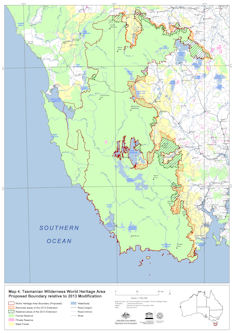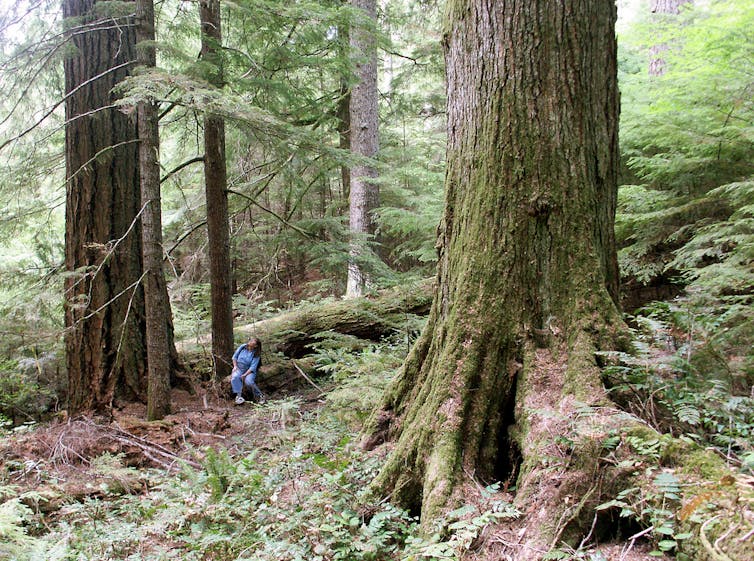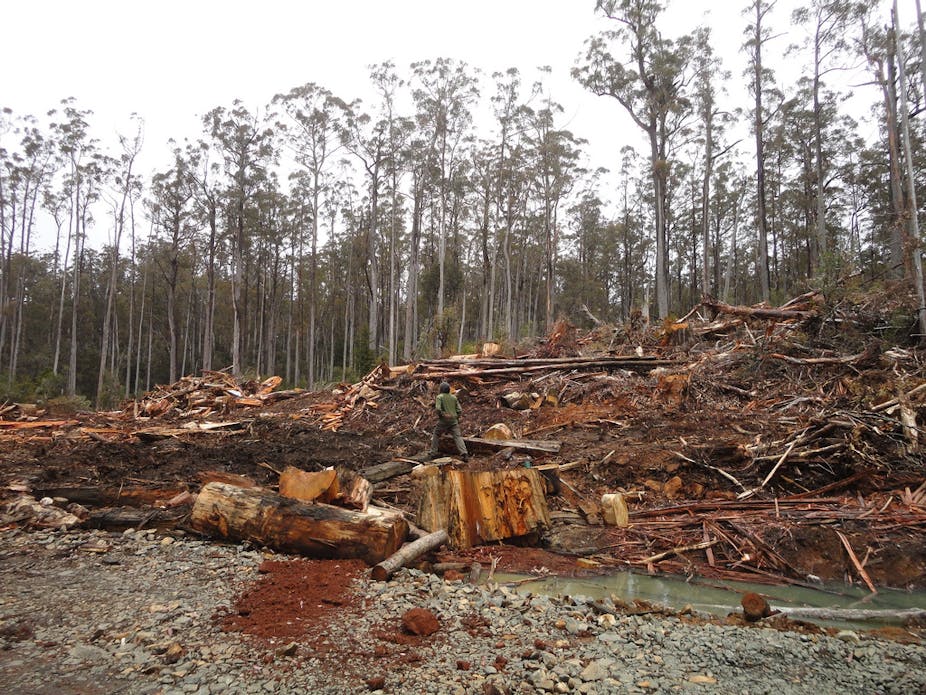The federal and incoming Tasmanian governments are pushing ahead with moves to delist parts of Tasmania’s forest World Heritage, on grounds that the area includes “degraded” forest.
But these “degraded” areas — mostly plantations and forests that have been thinned or clear-felled — form a small proportion of the proposed amendment. And evidence from overseas shows that worked forests do not necessarily detract from World Heritage values.
Around 74,000 hectares from Tasmania’s World Heritage will be removed. The delisting has raised the ire of many conservationists, and no doubt many within forest industries that were looking forward to not facing protesters many mornings of their working year.
“Too much locked up forest”
The economic argument for delisting parts of Tasmania’s forests was made explicitly clear during Tony Abbott’s now-infamous speech to the forestry industry. Abbott said we need unlocked forests to ensure a viable economic future and the renaissance of the forestry industry in Tasmania.
As a person who spends more time thinking about the ecology of forests rather than the economics, I’ll leave the analysis of that argument to others. However it is worth noting that the Australian Government has already commissioned a substantial amount of research, including diversifying Tasmania’s economy.
A “mockery” of World Heritage values

As part of Tasmania’s forest peace deal between environmental groups and the forest industry, approximately 172,000 hectares have been added to the Tasmanian Wilderness World Heritage area (see map). Approved by the World Heritage Committee, the extension awaits formal protection under state and Australian law.
But Abbott, his environment minister Greg Hunt, and Senator Richard Colbeck argue that this makes a “mockery” of World Heritage values, given that there are “degraded” areas within the proposed boundary.
They argue these areas detract from wilderness and heritage values, and have proposed amendments to the extension removing around 74,000 hectares.
Senator Colbeck has visually documented these degradations on his website — including forestry coupes in various stages of regrowth, forestry access roads, quarries, plantations and high voltage power lines.
The question is, do these patches truly detract from the heritage values of the entire estate? Or are these areas of little consequence to the integrity of the World Heritage Area?
Logged areas
We are yet to see an explicit statement of the area classed as “degraded” through logging. However, going from Colbeck’s images and the information in the delisting proposal, it appears that some of the areas have been recently clear-felled.
Other areas appear to have been thinned. For forestry, thinning promotes growth in the retained trees, enhancing their size (and value) when they are logged at a later date. But it can also have ecological benefits, enhancing forest structure, producing habitat, and increasing carbon storage.
Pine and eucalypt plantations
As well as areas affected by forestry operations, it has also been flagged that there are “pine and exotic eucalypt” plantations within the World Heritage Area.
This, of course, seems to go against the whole concept of a wilderness area or national park, though it is worth noting that there are a number of exotic plantations listed by the National Trust and managed under National Park authorities elsewhere in Australia.
International heritage consultant Peter Hitchcock helped design the original World Heritage boundary. According to his submission (which you can access here) to the Senate inquiry into delisting Tasmanian World Heritage, pine plantations take up around 0.008 hectares of the proposed 74,000 hectares to be removed.
To put that in perspective, that’s 0.4% of the area of the Melbourne Cricket Ground’s turf.
“Exotic eucalypt” plantations are likely to be Shining Gum Eucalyptus nitens, a species found naturally in Victoria and New South Wales.
While the species is by no means as “exotic” as a pine plantation, the presence of such these plantations does threaten the ecological integrity of the surrounding forests. But Hitchcock estimates these plantations take up roughly 190 hectares - 0.3% of the area proposed to be excised.
A way forward
It would be naïve to assume that these logged and plantation areas passed unnoticed under the original additions to Tasmania’s World Heritage Area.
The answer is that they weren’t. In fact, as others have observed on The Conversation, the “degraded areas” were acknowledged on the front cover of the initial proposal, and were invariably included to simplify the boundaries and minimise fragmentation of the new boundary.
As Hitchcock puts it in his submission: “Far better to patch the pothole in the highway to restore its integrity rather than abandon the highway”.
Perhaps we should view these “degraded” forests as unfinished but important pieces of the conservation puzzle. They could be a basis for ecological restoration and ecosystem management that could bring more value to the broader World Heritage Area.

Restoring heritage
The question of previously logged and replanted forest, nearby or within a newly reserved area, is not a new one.
In the Pacific northwest forests of the United States, when land managers sought to reserve tracts of old-growth Douglas fir forest, they found their efforts were complicated by the fact that the forests were often fragmented by younger forests that had been planted – often as a monoculture – after timber harvesting decades earlier.
The approach taken by the Forest Service was to then change the way they looked at managing these regrowing forests. Instead of managing for timber, they changed their goal to manage for old-growth.
This meant they looked at management options for promoting old-growth features within the plantations. They even employed thinning techniques which was found to have benefits to the forest structure, as were used in some of Tasmania’s “degraded” forests for different purposes.
There is not a one-size-fits-all management tool for every regrowing forest, and we should be wary of applying lessons globally to lessons locally.
But this case does show that for the areas that have identified as “degraded”, there is considerable scope to rehabilitate these forests. Maybe there’s an opportunity here for a “Green Army”?
Rehabilitation is an obligation for signatories to the World Heritage Convention. The Pacific northwest also provides an example Tasmania can look to and learn from.
Plus, as Forestry Tasmania has already pointed out – they’re pretty darn good at rehabilitating forests they once logged. Decades-old forestry coupes in the Styx have earned the badge of “high conservation value forest” in recent years.
I guess they could prove themselves to be the ultimate conservationists after all.

